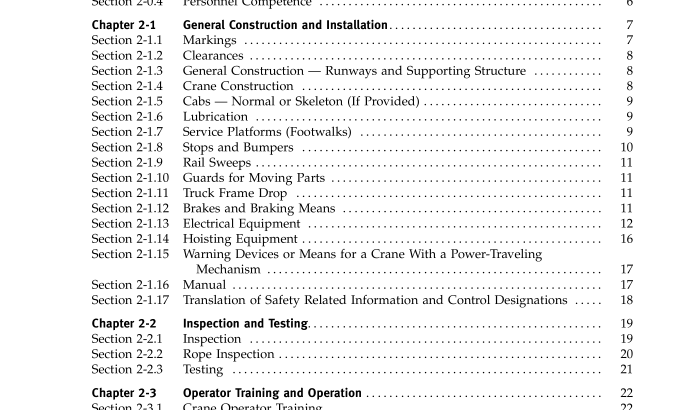ASME B30.2-2001 pdf free download.Overhead and Gantry Cranes (Top Running Bridge, Single or Multiple Girder, Top Running Trolley Hoist) Safety Standard for Cableways, Cranes, Derricks, Hoists, Hooks, Jacks, and Slings
SECTION 2-0.1: SCOPE OF B30.2 Volume B30.2 includes provisions that apply to the construction, installation, operation, inspection, and maintenance of hand-operated and power-driven over- head and gantry cranes that have a top-running single- girder or multiple girder bridge, with one or more top- running trolley hoists used for vertical lifting and low- ering of freely suspended, unguided loads consisting of equipment and materials (see Figs. 2-0.2-1 through 2-0.2-5).
The requirements included in this Volume also apply to cranes having the same fundamental character- istics such as cantilever gantry cranes, semi-gantry cranes, and wall cranes. Requirements for a crane used for a special purpose such as, but not limited to, non-vertical lifting service, lifting a guided load, or lifting personnel are not included in this Volume.
SECTION 2-0.2: DEFINITIONS abnormal operating conditions: environmental conditions that are unfavorable, harmful, or detrimental to or for the operation of a crane, such as excessively high or low ambient temperatures, exposure to adverse weather, corrosive fumes, dust-laden or moisture-laden atmo- spheres, and hazardous locations.
accessory: a secondary part or assembly of parts that contributes to the overall function and usefulness of a crane.
auxiliary hoist: supplemental hoisting unit usually of lower load rating and higher speed than the main hoist. brake: a device, other than a motor, used for retarding or stopping motion by friction or power means.
brake, holding: a friction brake for a hoist that is automati- cally applied and prevents motion when power to the brake is off.
brake, mechanical load: an automatic type of friction brake used for controlling loads in a lowering direction. This unidirectional device requires torque from the motor to lower a load but does not impose any additional load on the motor when lifting a load. braking means: a method or device used for stopping/ holding motion by friction or power. braking, control: a method of controlling speed by remov- ing energy from the moving body or by imparting energy in the opposite direction.
braking, countertorque (plugging): a method of controlling speed by reversing the motor line voltage polarity or phase sequence to develop torque in the direction 0PPO- site the rotation of the motor.
braking, dynammic: a method of controlling speed by using the motor as a generator, with the energy being dissi- pated in resistors.
braking, eddy current: a method of controlling or reducing speed by means of an electrical induction load brake. braking, emergency: a method of decelerating a drive when power is not available.
The braking effort may be established as a result of action by the operator, or automatically when power to the drive is interrupted.
braking, hydraulic: a method of controlling or reducing speed by means of displacement of a liquid. braking, mechanical: a method of contolling or reducing speed by friction.
braking, pneumatic: a method of controlling or reducing speed by means of compressed gas. braking, regenerative: a method of controlling speed in which the electrical energy generated by the motor is fed back into the power system. braking, service: a method to decelerate crane motion during normal operation.
bridge: that part of a crane consisting of one or more girders, trucks, end ties, footwalks, and drive mecha- nism, which carries the tolley or trolleys.
bridge travel: the crane movement in a direction parallel to the crane runway. bumper (buffer): a device for reducing impact when a moving crane or trolley reaches the end of its permitted travel, or when two moving cranes or trolleys come into contact.
This device may be attached to the bridge, trolley, or runway stop. cab: the operator ‘s compartment on a crane.
cab, skeleton: operator ‘s compartment used for occasional cab operation of a normally floor- or remote-operated crane. cantilever frame: a structural member that supports the trolley of a wall crane.ASME B30.2 pdf download.ASME B30.2-2001 pdf free download
